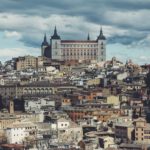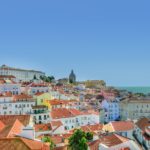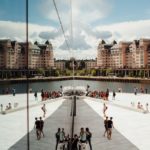Finding Picasso in Madrid

Madrid is home to some exceptional museums: the world-renowned Prado, an extensive National Archeology Museum, the Royal Academy of Fine Arts of San Fernando and the Museum of the Americas – devoted to items brought to Spain from the new world But, the two museums which most impressed me were the Thyssen-Bornemisza and the Museum Reina Sofia, which are devoted primarily to the work of Spanish artists. If you’re looking for the works of Pablo Picasso in Madrid, one of the country’s most famous artists, these are the places to visit.
The most well-know and important painting in the Reina Sofia collection is Picasso’s Guernica. At over 11 feet tall and 25 feet wide, it overwhelms and awes the viewer. No photograph of this painting can ever do it justice or have the impact the original does. Painted in response to the German strafing of civilians in a Basque village on market day, the picture evokes the horror and violence that occurred. Primarily a trial aerial bombardment by the German Air Force, this event evolved into the Blitzkrieg that was used extensively by the Germans during WWII.
The actual incident took place April 26, 1937 and was approved by General Francisco Franco, who led the Nationalist party during the Spanish Civil War. The Basques formed part of the Republican opposition to the Nationalists, and Guernica was considered a northern center of Basque culture and the resistance movement, making it a formidable target for the Nationalists. The bombing continued for over three hours. As most of the men of the village were away fighting in the resistance, so the victims were primarily women and children.
You cannot fail to see this disturbing picture of mutilated bodies, distorted faces, a woman weeping over a dead child, death and destruction without reflecting on the meaning.
Using only black, white and shades of gray, Picasso revealed the panic, chaos and suffering of people distorted by the grotesque viciousness of the attack. Images of warped, misshapen human and animal bodies are seen as though looking into the nightmarish scene from a window opening. The painting contains several hidden images only detectable when you see the original in person.
Picasso completed the painting in 35 days, and it was displayed at the 1937 World’s Fair in Paris, and then elsewhere around the world, including the San Francisco Museum of Art, The Museum of Modern Art in New York City and the Art Institute of Chicago. These exhibitions brought attention to the Spanish Civil War and aid to the Spanish War Relief. Franco won the Spanish Civil War, and ruled Spain with an iron fist as a dictator until his death in 1975.
Picasso requested that the work be held at the Museum of Modern Art (MoMA) in New York City; he did not want the painting to be returned to Spain until liberty and democracy had been established in the country. The painting was only returned to Spain after Franco’s death, and Spain had ratified a new constitution making it a democratic constitutional monarchy. MoMA sent the painting to Spain in 1981.
This painting made a very strong impression on me. You cannot fail to see this disturbing picture of mutilated bodies, distorted faces, a woman weeping over a dead child, death and destruction without reflecting on the meaning. But, within this powerful and universal anti-war message, there is also a suggestion of both hope and peace; the woman reaching out with the flame-lit lamp, a dove, a crack in the wall permitting light to enter and the rays of the rising sun. Not all these features can be seen unless you sit directly before this painting; they are nearly all invisible in photographs. So, if you visit Madrid, stop at the Museum Reina Sofia and take the time to sit before this significant work of art, examine it and review your reactions. Art is often reflective of its time and place. This is a painting that surpasses a moment in time and reaches out collectively.








Kurt,
We are becoming pen-pals. Thanks for the nice response. Yes, be sure to revisit Madrid – always a favorite of mine. By all means, visit the Thyssen Bornemizsa, one of the best museums I have ever seen.
Leigh, I saw this Picasso piece while it was at MOMA, years and years ago. It’s poignancy and power are viscerally staggering. I hope to get to Spain in my travels now that I’m retired. Your article is inspirational!
Thank you. I’m glad you enjoyed the article and even more thrilled that you have appreciation for the extraordinary piece of art.
Your article makes me want to get back to Madrid and see this late piece of artwork and more of Madrid.